Windows 10 S vs Chrome OS: Which is best for cheap laptops?
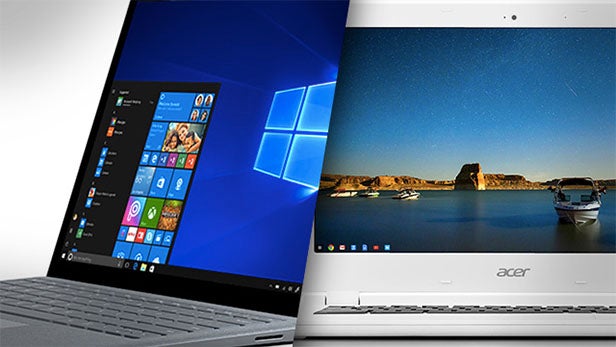
Windows 10 S vs Chrome OS: In the battle of ultra-light operating systems, Microsoft has taken aim at Google’s Chrome OS with the brand new Windows 10 S. Here’s our definitive guide to what’s different – and which one is better.
Windows 10 S has been pitched as an alternative to Google’s Chrome OS, reigniting the cheap laptop battle. But which is better, and which should be on your next laptop?
We’ve taken a look at the merits and pitfalls of both, so if you’re choosing for yourself or hoping to find a basic laptop for a loved one, read on.
Related: Surface Laptop vs Surface Book
Windows 10 S vs Chrome OS – Design and features
If you’ve used nothing but Windows laptops over the last few years, Windows 10 S will undoubtedly offer a more familiar experience than Chrome OS. The Start Menu and Desktop behave in pretty much the same way they always have, so if it’s consistency you’re after, Windows 10 S certainly has that.
Chrome OS is decidedly more basic, but that’s not to say it’s worse, especially considering the bargain basement devices that both operating systems will be running on. You get programs running windows in the familiar fashion, as well as a desktop and file explorer. There’s even a Start Menu of sorts, though it’s fairly simple.
However, Windows 10 S does offer a much better window management experience, which multi-taskers will appreciate. Both operating systems manage window-snapping, allowing you to fit two identically-sized windows on the left and right of your screen (Windows Button right or left arrow key on Windows 10 S, alt ( or ) on Chrome OS). Windows goes a lot further, though, allowing you to spread your workspace over multiple desktops (Windows Tab) and flick between them easily.
Related: Best laptops
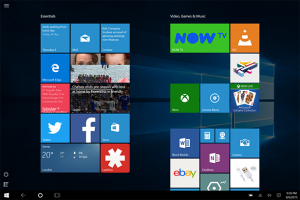
Windows 10 S also gets the benefits of Battery Saver mode, which automatically keeps your device from consuming too much power at the expense of screen brightness and performance.
And Windows 10 S’s file management system is more comprehensive than Chrome OS, plus the built-in image-editing tool is much more advanced, meaning you don’t have to resort to web apps or third-party programs.
Windows 10 S versus Chrome OS – Apps
This is where things get interesting, as both operating systems offer different answers to the problem of keeping things simple while still allowing some freedom.
Chrome OS, for the most part, is used in a web browser. This means that most applications are simply web pages, although some do run outside the browser. This is great for simplicity but has a big effect on performance and the actual tasks you’re able to complete.
For example, if you use Spotify you’ll have to use a version of the web player, which isn’t particularly great and doesn’t hook into your Chromebook’s media playback buttons. So you’ll have to navigate to and from the app to play, pause and skip.
Related: Best laptops for students
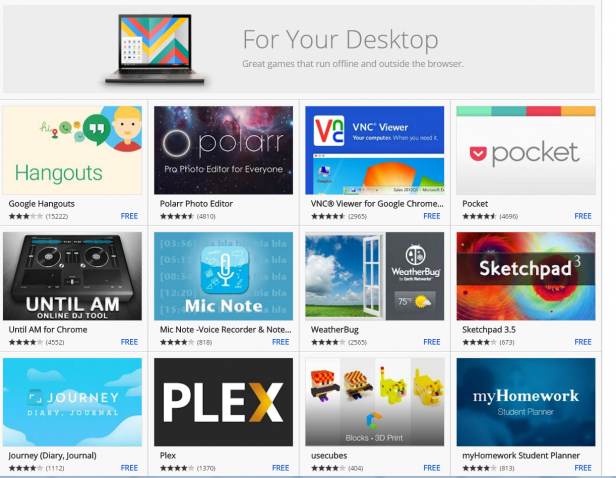
Using the Spotify example for Windows 10 S, it’s clear that Microsoft has an advantage here. Windows 10 S supports any Universal Windows Platform (UWP) application, i.e. anything that you can download from the Windows Store.
This means apps are simple and don’t hog resources or present a privacy risk. But they also hook into Windows; in the case of Spotify, you’ll be able to use your media keys to play and pause, and any notifications that Spotify fires will appear in the Notification area of Windows 10 S.
In fairness, Chrome OS has muddied the water a bit by allowing Android apps to be installed on Chromebooks. This feature is still very much in beta and while we haven’t yet been able to test it, there are some limitations. That’s mostly down to the fact that most apps aren’t optimised to run on a larger screen with a keyboard and touchpad.
The huge advantage is there’s a much wider variety of apps on Google’s Play Store, and while not all of them will be optimised for laptops, being able to use them at all is still pretty great.
The Windows Store, meanwhile, has grown in terms of app selection. There are 989 ‘Top Free’ apps at the time of writing, with a further 563 ‘Top Paid’. That probably doesn’t reflect the full extent of the Windows app library, but considering a three-star app called ‘Business Contacts’ that was last updated in 2014 is on that list of ‘top’ apps, we’d say the barrel is probably being scraped at this point.
Related: Microsoft Surface Laptop
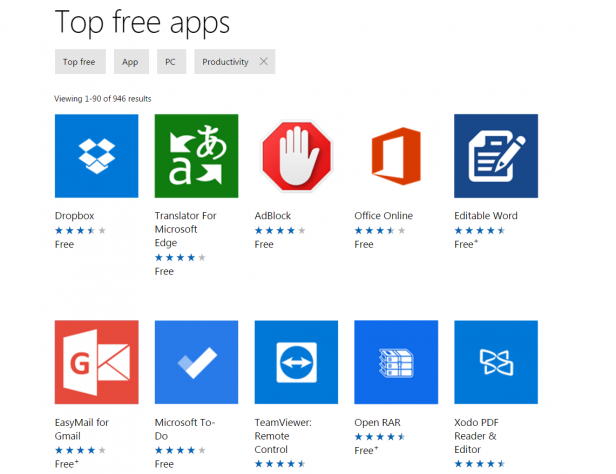
Of course, if you go beyond the Windows Store, the wide open internet has literally millions of Windows-compatible programs. But Windows 10 S is locked to the Windows Store for good reason; there’s loads of dangerous and naff applications out there online, and by limiting the scope of the stuff you can actually use, Microsoft has made Windows 10 S more secure. However, if you discover Windows 10 S is too limiting for you, you will be able to upgrade to Windows 10 Pro for around £50/$50.
Windows 10 S vs Chrome OS – Productivity
On a basic laptop, the productivity software that really matters is the stuff you use the most, so we’re going to focus on web browsing, office applications and email here.
Web browsing
With Windows 10 S, you’re limited to using Microsoft Edge. Edge is by no means a bad browser – it actually does all the basics very well and is pretty darn fast, making it an attractive piece of software. It is basic, though, so power-users will probably want to look elsewhere for a browser with more customisation options.
Windows 10 S also locks you to the Bing search engine on Edge by default. We can see why Microsoft has done this; it can curate the results on Bing to keep its users safe, which is all well and good – apart from the fact we don’t really rate Bing for much at all. It consistently offers up dodgy links to websites we don’t trust, doing so far more than Google. It has some nice tools, but it’s hard to be dragged away from Chrome.
Of course, you’re free to go to Google.com to get your searching done, but if you type a search into the Start Menu or the Edge URL bar, you’ll be directed to Bing and there’s no way to change it. Similarly, Chrome OS is locked to Chrome, but that’s no bad thing, as Chrome is the best web browser around. You’re not locked to Google search either, if you don’t want to be, with Chrome making it easy to change your default search engine.
Related: Best web browser
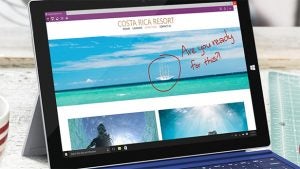
Email
Chrome OS doesn’t have a dedicated email client; whatever email service you use will need a web-based interface in order for you to use it. Windows 10 S has a built-in email client that supports Office 365, Exchange, Outlook.com, Gmail, and Yahoo. It’s fast and simple, and a very handy tool, giving Windows 10 S an edge here.
Documents
Windows 10 S supports Microsoft Office 365, and we’d expect most laptops sold with it to come with a one-month free trial, if not a full year’s subscription. This means you get access to the fully-featured desktop applications of Word, Excel, PowerPoint, OneNote, Access, Publisher and Outlook. After your free trial ends, you’ll have to pay a fee of £60 a year to keep using them.
You’ll also be able to use online office software, including Microsoft Office Online.
Chrome OS works best with Google Drive, which includes Docs, Sheets and Slides. They all do the basics well, although we do find Microsoft Office to be much better for professional use. For quick and easy documents and spreadsheets, though, Drive is very good and would prove adequate for most students.
Windows 10 S vs Chrome OS – Which is best?
In the end, the operating system you pick will depend on the device you buy. With prices for both Windows 10 S and Chrome OS laptops starting at under £200/$200, it’s going to be a tight battle.
Windows 10 S is a more powerful operating system than Chrome OS and is more flexible. However, having not yet used it on a cheap laptop, we can’t vouch for whether it’ll offer the same, snappy performance as Chrome OS.
Related: Surface Laptop vs MacBook Pro

So, to hedge our bets a little, we reckon Windows 10 S laptops will prove to be better value than Chrome OS models – if performance is up to scratch.
As it stands, there two things that you’ll want to think about before choosing Windows 10 S: Are you okay with typing in Google.com every time you search, and are you willing to accept the limitations of the Windows Store? If it’s a yes to both, then it’s all looking very promising for Windows 10 S.
Related: Windows 10 S laptops
(video id=5175060105001)
Do you prefer Microsoft’s Windows 10 S or Google’s Chrome OS? Let us know (and why) in the comments below.


